Ensuring Workplace Safety: Key Aspects of OHS Training, Consultation, and Documentation

Workplace safety is a critical aspect of any organization, and a well-structured Occupational Health & Safety (OHS) management system ensures a safe and compliant work environment. Key components such as training, competency assessment, consultation, and document control play a vital role in maintaining OHS standards. Employees, contractors, and visitors must be adequately trained and aware of workplace hazards and safety procedures. Effective communication and consultation channels help organizations involve employees in hazard identification and risk management. Proper documentation and control measures ensure compliance with regulations and continuous improvement in safety performance.
Procedures shall be in place to ensure that OHS competencies are developed and maintained. The personnel shall be assessed as competent for OHS responsibility, on the basis of skills achieved through
- Education,
- Training
- Experience
The organization shall ensure that all personnel, including contractors and visitors have undertaken training appropriate to the identified needs.
Persons with appropriate knowledge, skills and experience in OHS and training shall carry out training.
The organization shall ensure that personnel to be competent to perform task which impact upon health & safety
Procedure to be developed to make employees aware of
- The importance of conformance with the OHS policy and procedures and the consequences of departure:
- The OHS consequences, actual and potential, or their work activities, and the benefits of improved performance;
- Their specific roles and responsibilities to enable OHS conformance.
Training procedures shall take into account levels of
- Responsibility, ability and literacy, and risk.
CHECK: Job descriptions, training records, operational procedures etc.
- An analysis of competency and training needs has been undertaken. Training programmes/plans for individual employees have been developed.
- Range of training courses/products available for use within the organization
- Training records, and records of evaluation of effectiveness of training.
- Verify training records for contractors and visitors, as applicable
AS/NZS Consultation, Communication and Reporting/OHSAS Communication, Participation and Consultation
The organization shall have a documented procedure for employee involvement and consultation for OHS issues and how information is communicated to and from employees and interested parties. Employees shall be;
- Involved in the development and review of policies and procedures to manage risk;
- Consulted where there are changes that affect workplace health and safety;
- Informed of their OHS representative(s) and management representative
Typically consultation, communication and employee participation can be achieved by using;
- Team-briefing;
- Health & Safety Councils and Committees;
- Employee involvement/input into Hazard identification & Risk Control;
- Suggestion Schemes;
- Notice Boards;
- Newsletters… etc.
Reporting
Types Of Certification
- ISO Certification
- ISO 9001 Certification
- ISO 14001 Certification
- ISO 45001 Certification
- ISO 22000 Certification
- ISO 27001 Certification
- ISO 17025 Certification
- ISO 13485 Certification
- ISO 20000-1 Certification
- ISO 22301 Certification
- ISO 50001 Certification
- ISO 37001 Certification
- IATF 16949 Certification
- ISO 29001 Certification
- ISO 31000 Certification
- ISO 20121 Certification
- ISO 10002 Certification
- ISO 41001 Certification
Get Free Consultation
Our Clients


















Procedures for timely reporting shall be established. Reporting to cover
- OHS performance reporting
- Reporting of incidents and system failure
- Reporting on hazard identification
- Reporting on hazard/risk assessment
- Reporting on preventive and corrective action
- Statutory reporting requirements
What to look for as an auditor
- That all employees have been made aware of their employee DH&S representative(s), and specified management appointee.
- Evidence of formal management and employee consultations, in particular where there are changes that affect workplace health and safety. e.g. Minutes of OHS councils, trade union, health and safety meetings, Team Briefings etc. (where appropriate);
- Employee involvement in hazard identification, risk assessment and risk control process; including the development and review of policies and procedures.
- Risk assessment procedure and risk assessments.
- Initiatives to encourage employee OHS consultation, review and improvement activities in the workplace, and feedback to management on OH&S issues ep Suggestion schemes for OHS improvement, Team Briefing, OHS improvement teams.
- OHS briefings for employees and other interested parties, e.g. contractors or visitors, e.g. Employee, Contractor and visitor induction procedures for OHS briefings, and any other mechanisms the organization may use to make the stated parties aware of any OH&S changes
Documentation
The organization shall establish, implement and maintain information in paper or electronic form that;
- OH&S policy and objectives
- Describe the scope of OH&S management system
- Describes the core elements of the OH&S management system and their interaction;
- Documents including records required by the standards and required by the organization
- Provides direction to related documents.
What to look for as an auditor
- Document control procedures exist, which include assigned responsibilities and authorities.
- Evidence that the procedure is being followed, and that the organization has full control over all of the documents forming part of the OHS management system.
- Document registers, master lists or indexes.
- List of controlled documentation.
- Ensure that all OHS documentation issued is of the same issue status as the ‘master’ document, and there is no evidence of superseded documents in circulation.
- Legal requirements are kept up to date
- Obsolete copies of legal and other documents are maintained for reference and protected against unintended use e.g. securely stored, identified as ‘obsolete’, ‘archived’, ‘superseded’ or similar,
- Examples of documentation – OHS Policy, Manuals, Procedures, Technical Data Sheets, Risk Assessments, Objectives and Targets, Management Programmes, Registers of Legislation, Induction Manuals etc.
- Verify that staff has access to the relevant legislative requirements.
Conclusion
An effective OHS management system ensures workplace safety through proper training, employee involvement, and strong document control. Clear communication and compliance with regulations help manage risks and foster a safety culture. Prioritizing these aspects creates a safer, healthier, and more productive work environment.
GET A FREE CONSULTATION NOW
FAQ
What are the key components of an effective OHS management system?
Key components include training, competency assessment, employee consultation, incident reporting, and document control to ensure a safe and compliant workplace.
Why is consultation important in workplace health and safety?
Consultation helps employees share safety concerns, improve hazard awareness, and support safer work practices through active participation.
How does documentation support workplace safety?
Proper documentation tracks training, procedures, and risks, helping ensure compliance and improve safety over time.
